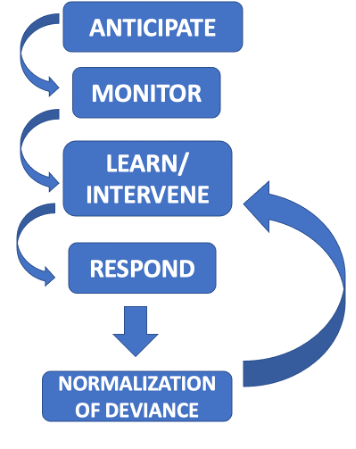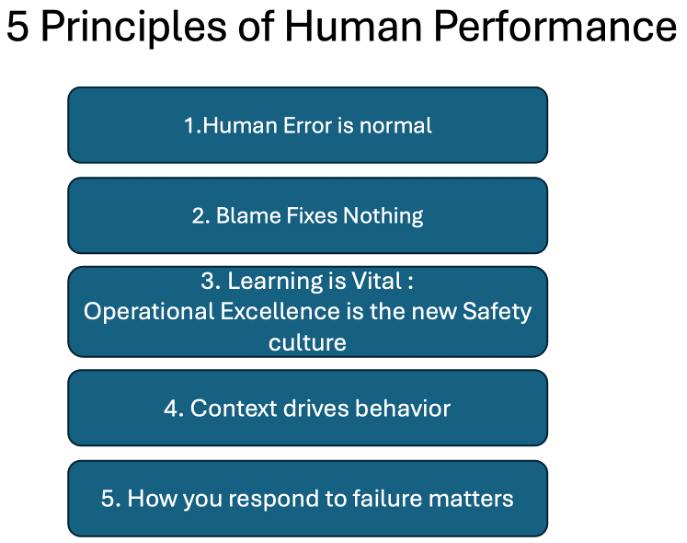Copy link
Resilience Engineering in Healthcare
Last updated: 09/06/2024
Key Points
- Resilience engineering is a concept in healthcare safety focused on being proactive rather than reactive to events.
- “Safety 2” primarily focuses on what goes right rather than what goes wrong.
- Differences in Safety-2 concepts include human performance, adaptability, “drift into failure,” “work-as-imagined versus work-as-done,” “efficiency thoroughness trade-off,” and resilience engineering.
Introduction
- Historically, the goal of “safety” was to minimize all errors. More recently, the concept of “safety” has been to provide anticipatory guidance for a team or a system with the infrastructure to support the variability within the system.
- Safety-1 processes have evaluated system safety and focused on being reactive to events and safety culture, with hindsight highlighting failures and errors, like “putting out fires for a firefighter.”
- This analogy dictates that the fire would be the event, and putting out the fire was the safety or event analysis. This is done reactionarily to look for the “cause” of the fire.
- Safety 2 focuses on being proactive and better understanding how events can occur and how to anticipate and predict the potential for problems.1
- Much of this same concept is rooted in resilience engineering in healthcare.
Understanding Safety
- Dr. Todd Conklin focuses on what he calls the “New View of Safety.” The definition of safety is “not the absence of accidents,” but is it the “presence of capacity.”2
- How much can your system and team members handle?
- How resilient is your system?
- How easily can your organization bounce back when an event occurs?
- Drs. Hollnagel and Woods state: “A resilient organization treats safety as a core value, not a commodity that can be counted.”1
- It is paramount to understand that safety is a journey that may change along the way. The concept is less reflective of the end goal or counting the number of errors or events.
- The resiliency of an adaptable team is instrumental in guiding an organization to make the best decisions as adaptations occur.
- Safety 2 is a concept described by many teams in aviation and other nuclear power industries. It highlights the importance of human performance and the worker’s ability to adapt to an ever-changing world to mitigate errors and improve system performance.
- The adaptability of the teams and team-based learning emphasizes the “resilience” of that team.
- People come to work to do their best but face challenges and barriers.
- Failures of an individual or a system will become a barrier to a system that seeks to care for complex patients in an uncertain environment and will evolve into a more resilient system.3
Concepts of Resilience Engineering
- Resilience engineering also highlights that teams and systems have to function so that they can anticipate, monitor, respond to, and learn from ongoing challenges and processes and then utilize these opportunities to adapt to organizational processes (Figure 1).

Figure 1. The resilience engineering model uses natural feedback to anticipate, monitor, learn, and respond. Courtesy of Megha Kanjia, MD.
- Being able to anticipate the needs of a system is firmly based on the individuals working within the system.
- Conklin has identified the 5 Principles of Human Performance (Figure 2) which help to understand the “why” of how workers perform, as well as principles to guide performance within organizations. Discussion of normal safety standards and understanding how the team members would function in the system is critical in comprehending how processes move forward within systems.

Figure 2. Conklin’s 5 Principles of Human Performance. Adapted from Conklin, T. (2019). The 5 Principles of Human Performance: A contemporary update of the building blocks of Human Performance for the new view of safety. Pre-Accident Investigation Media
- The idea of “resilience” reflects an ability to bounce back or return to a working pattern after undergoing or suffering from an event or impact.
- This concept reflects that an organization can learn from experiences and improve outcomes based on learnings that occur.
- Hollnagel and Dr. Sydney Dekker describe concepts such as “drift into failure,” “efficiency thoroughness trade-off,” and “work-as-imagined versus work-as-done” that demonstrate the organizational opportunities to understand the living system.
- It adapts to the new world, which is more Volatile, Uncertain, Complex, and Ambiguous (VUCA) than previously described.4,5
- Examining the real-time process of the work being done allows leaders to better understand work as it is actually accomplished rather than how a nonworker may imagine it is being done. The ultimate goal is a true balance of efficiency and thoroughness.
- This is also an opportunity for a culture of safety to be present in the conversations of front-line teams and leadership within an organization. As environments change and become more complex, the adaptability and resilience of individuals are critical, and the culture of safety must continue to facilitate this.
- The concept of “drift into failure” assumes a stepwise change in process that occurs repeatedly. This results in a very different process from the original plan, otherwise known as “normalization of deviance.”4
- Because the processes described here evolve, given the complexity of our everyday work, this concept helps to improve our everyday workflows.
- For this reason, understanding a work process is improved by the ability to Anticipate issues and barriers, Monitor events and changes that occur, Learn from these events, and Respond appropriately to new information within living organizations.
- Lastly, the work of a resilient organization is never completed; continued monitoring and understanding of changing systems must be examined and processes must change.
- A set-it-and-leave-it approach will likely result in failure since constant monitoring, learning, anticipation, and responding allow the evolution of a resilient organization and team to continue.
References
- Hollnagel E, Woods DD, Leveson N. (Eds.). (2006). Resilience engineering: Concepts and Precepts. Ashgate Publishing, Ltd.
- Conklin, T. The 5 Principles of Human Performance. PreAccident Media; 2019.
- Hollnagel E, Wears RL, Braithwaite J. From safety-I to safety-II: A white paper. Denmark: Resilient Health Care Net. 2015 Link
- Dekker S: Drift into failure: From hunting broken components to understanding complex systems (1st Edition.). CRC Press, Boca Raton, FL, 2011
- Hollnagel E: The ETTO Principle: Efficiency-Thoroughness Trade-Off: Why Things That Go Right Sometimes Go Wrong (1st Edition). CRC Press, Boca Raton, FL, 2009. Link
Other References
Copyright Information

This work is licensed under a Creative Commons Attribution-NonCommercial-NoDerivatives 4.0 International License.